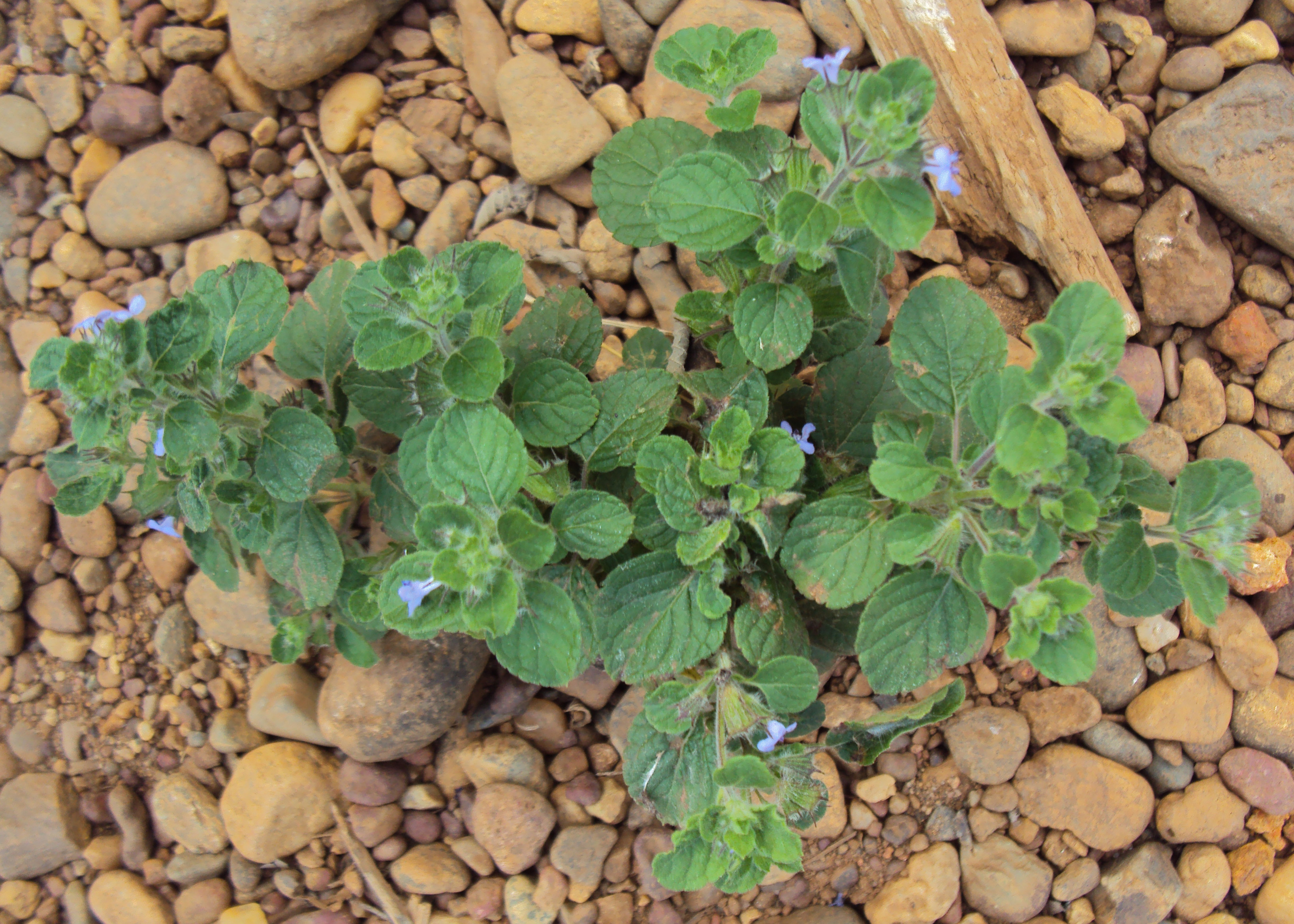Hyptis suaveolens

|
|
Hyptis suaveolens Common Names: Bush mint, Pignut, Chan, Wild spikenard Scientific
Classification Kingdom: Plantae Clade: Tracheophytes Clade: Angiosperms Clade: Eudicots Clade: Asterids Order: Lamiales Family: Lamiaceae Genus: Hyptis Species: H. suaveolens Synonyms: Mesosphaerum suaveolens (L.) Kuntze, Ballota suaveolens L., Hyptis plumieri Poit. Morphological Description Hyptis suaveolens is an erect, aromatic annual or short-lived perennial herb,
typically 1–2.5 meters tall, with a robust, branching habit. Its key
characteristics include: · Stems: Quadrangular, densely pubescent with glandular and
non-glandular hairs, green to purplish, woody at the base in older plants
(Harley, 1988). · Leaves: Opposite, ovate to elliptic (5–10 cm × 2–5 cm), with
serrated margins, acute to acuminate apex, and rounded to cuneate base; densely
hairy, emitting a strong minty aroma when crushed (Prance & Jongkind,
2015). · Inflorescences: Axillary or terminal clusters of small,
tubular flowers (5–7 mm), pink to purple, with a 5-lobed calyx and corolla;
flowering occurs year-round in tropics, peaking during the rainy season
(July–October) (Kew Science, n.d.). · Fruit: Nutlets (1–2 mm), dark brown, enclosed in persistent calyx,
dispersed by wind or adhesion (Fern, 2024). Distribution and Habitat Hyptis suaveolens is native to the tropical Americas but widely naturalized in
tropical and subtropical regions: · Geographic Range: Native to Central and South America
(Mexico to Brazil); naturalized in Nigeria, Ghana, India, Australia, Southeast
Asia, and Pacific Islands; in Nigeria, prevalent in southern (e.g., Lagos,
Ogun) and northern (e.g., Kano, Kaduna) regions (Kew Science, n.d.; Burkill,
1985). · Habitat: Thrives in disturbed areas (roadsides, wastelands,
farmlands), open fields, and forest edges; prefers well-drained, sandy or loamy
soils (pH 5.5–7.5) with full sunlight and 800–2,000 mm annual rainfall; occurs
at elevations up to 1,500 m (Harley, 1988; Fern, 2024). · Ecological Role: Pioneer species in disturbed areas;
attracts pollinators (bees, butterflies); can be invasive, outcompeting native
flora in some regions (Burkill, 1985). Ethnopharmacology Hyptis suaveolens is a cornerstone of traditional medicine in Nigeria and
other tropical regions, valued for its antimicrobial, anti-inflammatory, and
antimalarial properties. Its pharmacological potential is driven by a rich
phytochemical profile, with studies validating numerous traditional uses. Traditional Uses In Nigerian
ethnomedicine, particularly among Yoruba, Igbo, and Hausa communities, Hyptis suaveolens is used for: · Respiratory Conditions: Leaf decoctions treat cough, asthma, and
bronchitis. · Gastrointestinal Disorders: Leaf infusions manage diarrhea, dyspepsia,
and intestinal worms, attributed to antimicrobial and astringent properties
(Neuwinger, 2000). · Skin Infections: Leaf pastes are applied to wounds, burns,
and fungal infections for antiseptic and healing effects (Burkill, 1985). · Malaria and Fever: Leaf and stem infusions are consumed as
antimalarial and febrifuge remedies. · Pain and Inflammation: Leaf extracts relieve headaches, menstrual
cramps, and joint pain (Neuwinger, 2000). · Insect Repellency: Leaves are burned or crushed to repel
mosquitoes, used in traditional vector control (Burkill, 1985). Pharmacological Studies Pharmacological studies
have validated several traditional uses of Hyptis suaveolens, focusing on its leaves, stems, and essential
oils: · Antimicrobial Activity: Methanolic leaf extracts inhibited Staphylococcus aureus (MIC: 0.5 mg/mL), Escherichia coli (MIC: 1 mg/mL), and Candida albicans (MIC: 2 mg/mL), with inhibition zones of
12–18 mm at 100 mg/mL. Essential oils (camphor, 1,8-cineole) disrupted
microbial membranes, supporting use for skin and gastrointestinal infections
(Moreira et al., 2010). · Antimalarial Activity: Ethanolic leaf extracts exhibited
antiplasmodial activity against Plasmodium berghei · Anti-inflammatory and Analgesic Effects: Ursolic acid from leaf extracts reduced
carrageenan-induced paw edema in rats by 42% at 100 mg/kg and acetic
acid-induced writhing by 50% (p<0.05), supporting use for pain and
inflammation (Gavamukulya et al., 2014). · Antioxidant Activity: Methanolic leaf extracts showed DPPH
scavenging (IC50: 40 µg/mL), attributed to flavonoids (quercetin) and phenolic
acids (gallic acid). This supports its role in preventing oxidative
stress-related diseases (Sharma et al., 2013). · Insect Repellent Activity: Essential oils (1% concentration)
repelled Aedes aegypti mosquitoes
for up to 2 hours, comparable to DEET, due to camphor and eugenol content,
validating traditional use for vector control (Conti et al., 2012). ⚠ Safety
Considerations: Hyptis suaveolens is
generally safe at therapeutic doses, but some risks are noted: High Doses:
Acute toxicity studies showed no mortality in rats at methanolic leaf extract
doses up to 5,000 mg/kg (LD50 > 5,000 mg/kg), but sub-chronic doses
(>1,000 mg/kg) caused mild liver enzyme elevation (ALT increased by 10%) (Gavamukulya
et al., 2014). Essential Oils: High concentrations of camphor and eugenol may
cause skin irritation or respiratory discomfort in sensitive individuals (Conti
et al., 2012).
Additional Information · Taxonomic Context: Part of the Hyptis genus (~300 species),
known for aromatic essential oils; reclassified as Mesosphaerum suaveolens in some taxonomies, but Hyptis suaveolens remains widely
accepted (Harley, 1988). · Ecological Role: Enhances biodiversity in disturbed
ecosystems; nectar supports pollinators; can be invasive, forming dense stands
that displace native flora (Fern, 2024). References
External Links More Pictures |
|
| Compounds of Hyptis suaveolens | |
| References |